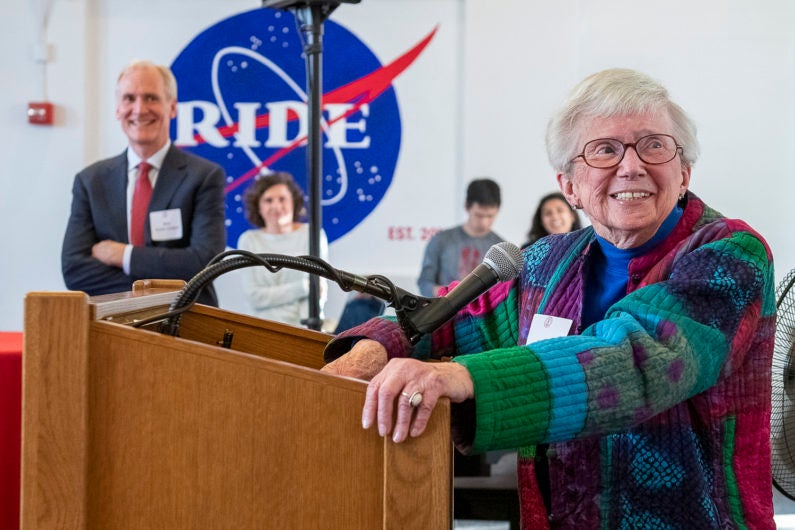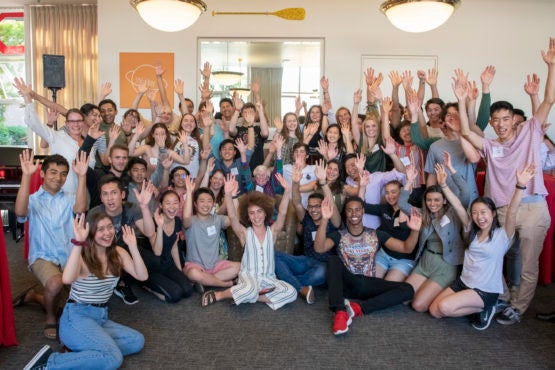Stanford alumna Sally Ride remembered with residence hall renaming
Members of the campus community gathered to rename a residence hall in memory of pioneering astronaut Sally Ride. Also at the event, Stanford President Marc Tessier-Lavigne acknowledged and honored the contributions of Native Americans to Stanford University.

Joyce Ride, mother of Sally Ride, speaks at the dedication of the Sally Ride House in Stern Hall. (Image credit: L.A. Cicero)
It was more than four decades ago when Sally Ride, the first U.S. woman in space, walked the Stanford campus, probably looking much like any other undergraduate.
Ride would go on to earn four Stanford degrees – two undergraduate degrees in English and physics and two graduate degrees in physics – before becoming one of the most famous and recognizable women in the world as an astronaut, university professor, entrepreneur, author and champion of STEM education for women and minorities.
She was best known for her historic flight aboard the space shuttle Challenger in 1983, when she became the first American woman to go into space. She died in 2012 after having founded Sally Ride Science to inspire young people – especially girls – to pursue careers in science, technology, engineering and math. She was posthumously awarded the Presidential Medal of Freedom in 2013.
On Thursday, Stanford ensured that Ride will always be remembered at her alma mater by naming the former Serra House student residence in the Stern Hall complex in her honor.
Provost’s memories
The ceremony attracted more than 100 members of the Stanford community, as well as members of Sally Ride’s family. Her mother, Joyce, was among those who spoke about Ride and her legacy.
Also speaking was Provost Persis Drell, who met Ride in the late 1980s when Ride worked with Drell’s late father, Sidney Drell, at the Stanford Center for International Security and Arms Control (CISAC, now the Center for International Security and Cooperation).
Drell told the crowd, “At the time when Sally was at Stanford, she was such a celebrity that they had to keep her name off the CISAC roster, and she was in an unlabeled office because they were worried that she would be stalked and her work constantly interrupted.”

Students of the Sally Ride House “Reach for the Stars” with Joyce Ride, Sally’s mother, at the dedication of Sally Ride House. (Image credit: L.A. Cicero)
Drell said that her father and Ride remained close friends after Ride left Stanford and accepted a professorship in physics at the University of California, San Diego.
She added, “In addition to meeting Sally through my Dad, I had the privilege of working with her on a university visiting committee. She was just as much a hero to me as to everyone else. She was graceful, smart, strategic, reserved and low key. She handled her incredible fame extraordinarily gracefully, and I have always thought the fame must have been hard for her, given her naturally reserved nature.”
Thursday’s renaming ceremony comes two months after Stanford announced it would rename Serra House for Ride and the headquarters of the Clayman Institute for Gender Research – also named Serra House – for alumna Carolyn Lewis Attneave, an internationally renowned scholar and psychologist who was instrumental in creating the field of Native American mental health. The renaming ceremony in memory of Attneave will take place on Tuesday, April 30.
Both buildings had been named for Junipero Serra, a Catholic missionary whose practices in converting Native Americans in the 1700s have come under scrutiny in recent years.
Native American contributions
As part of Thursday’s ceremony, President Marc Tessier-Lavigne acknowledged that Stanford lands were once the home of the Puichon Thámien Ohlone, Native Americans who were the ancestors of the Muwekma Ohlone Tribe at Missions Dolores, Santa Clara and San José.
“The lands on which Stanford University was established were and continue to be of significance to the Muwekma Ohlone Tribe,” said Tessier-Lavigne, adding, “I want to take a moment to acknowledge this significance, to also honor the many contributions that Native Americans have made to Stanford and also to recognize the history of Native Americans on this land.”
Tessier-Lavigne also acknowledged the efforts of members of the campus community who worked through the many issues involved in evaluating the use of the Serra name on campus and selecting Ride and Attneave as honorees.
“In the end, this hard work has reaffirmed Stanford’s values – and particularly the priority we place on inclusion,” he said.
That thanks was reiterated by Sally Ride House resident fellow Michelle Reininger, who specifically noted the contributions to the renaming process of residents of Sally Ride House and of members of the Native American community at Stanford.
Reininger, assistant professor (research) at the Center for Education Policy Analysis, asserted that the names we attach to buildings matter because they reflect the values and aspirations of a community.
The Sally Ride House renaming, she said, gives Stanford the “opportunity to speak to the world what we want these walls to hold. We want them to hold all members of our community; we want them to hold hope and inspiration, tenacity and a desire to make our world a better place.”
